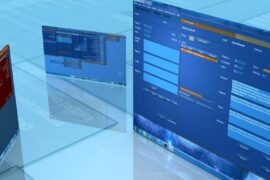SCADA or Supervisory Control and Data Acquisition is an automation control system for gathering and analyzing information in real time. SCADA systems are used in various industries like telecommunications, water and waste, oil and gas, energy, refining, transportation, and power to monitor and control plant equipment.
How do SCADA Systems Work?
It has a centralized system that is capable of controlling entire sites, from industrial plants to a whole complex of plants across the country. The system uses signals to communicate via channels, providing the user with remote control of any equipment in a particular system. Systems can be fairly simple such as monitoring environmental conditions in a small office building, or it can be incredibly complex such as monitoring a municipal water system or the entire activity in a nuclear power plant. It gathers critical information, such as where a leak has occurred for example in a pipeline, then transfers this information to the central site, alerting the home station that a leak has occurred.
At the same time, it carries out necessary analyses and controls such as establishing whether the leak is critical and displays everything in an organized and logical fashion.
A SCADA system also implements a tag or distributed database that contains points throughout the plant that represent a single input or output valve monitored and controlled by the centralized system in the control room. These points are stored as value-timestamp pairs in the distributed database. It is common practice to set up a SCADA system to acquire metadata such as alarm statistics and PLC (Programmable Log Controller) register paths.
Inside the SCADA System
While SCADA is used to simplify a given infrastructure, the system’s components are somewhat complex and include five essential parts:
- HMI (Human Machine Interface) processes data from the tags or points to send to a human operator who is then able to monitor or control the system.
- Supervisory System – gathers data sent from the tags and sends operations or commands to the process.
- RTUs (Remote Terminal Units connect sensors, convert the signals to digital data, and sends it to the supervisory system where it is stored in the distributed database.
- PLCs (Programmable Logic Controllers) are used as field devices since they are much more economical and versatile than process specific RTUs.
- Communication Infrastructures deliver connectivity to the supervisory system and from there to the RTUs and PLCs for the operator to command.
The infrastructure is required to relay data from the remote RTUs or PLCs that run along pipelines, water supplies, and electric grids.
Communication is the single most essential link for the SCADA system to operate correctly, however, how successful the system can be is fundamentally determined by how well the communication from the Human Machine Interface to the electronic devices RTUs and PLCs is managed.
Where is SCADA Used?
SCADA systems and technology are used to manage a wide range of equipment. Typically they are used to for the automation of complex processes where the use of human control proves impractical such as the challenges of proving 24 hours per day monitoring.
Well-designed SCADA systems can also be of benefit for systems with more control factors or systems with faster-than-human control factors. With the careful implementation of rule sets system operators can be assisted with routine management functions, allowing human assets to focus more on decision making and bigger-picture analyses.
Around the world the following operations are controlled by SCADA:
• Electric Power Generation, Transmission, and Distribution
SCADA systems are used in electric utilities to detect line voltage, current flow, monitor circuit breaker operations, and put sections of a power grid on- or offline.
• Manufacturing
SCADA systems are used to monitor quality control and process, regulate robots and industrial automation and manage parts lists in just-in-time manufacturing.
• Facilities, Buildings, and Environments
SCADA is used by facility managers to control entry systems, lighting, refrigeration, and HVAC systems.
• Water and Sewage
SCADA systems are used by state and municipal water facilities to regulate and monitor water flow, pipe pressure, reservoir levels, and other factors.
• Traffic Signals
SCADA systems regulate traffic lights, detects out-of-order signals, and controls traffic flow.
• Mass Transit
SCADA is used by transit authorities to regulate trams and trolley buses, regulate electricity to subways, automate rail traffic signals, control railroad crossing gates, and to locate buses and trains.































